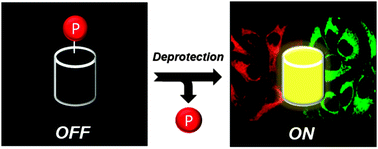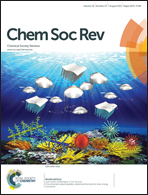Development of fluorescent probes based on protection–deprotection of the key functional groups for biological imaging†
Abstract
Recently, the strategy of protection–deprotection of functional groups has been widely employed to design fluorescent probes, as the protection–deprotection of functional groups often induces a marked change in electronic properties. Significant advances have been made in the development of analyte-responsive fluorescent probes based on the protection–deprotection strategy. In this tutorial review, we highlight the representative examples of small-molecule based fluorescent probes for bioimaging, which are operated via the protection–deprotection of key functional groups such as aldehyde, hydroxyl, and amino functional groups reported from 2010 to 2014. The discussion includes the general protection–deprotection methods for aldehyde, hydroxyl, or amino groups, as well as the design strategies, sensing mechanisms, and deprotection modes of the representative fluorescent imaging probes applied to bio-imaging.


 Please wait while we load your content...
Please wait while we load your content...